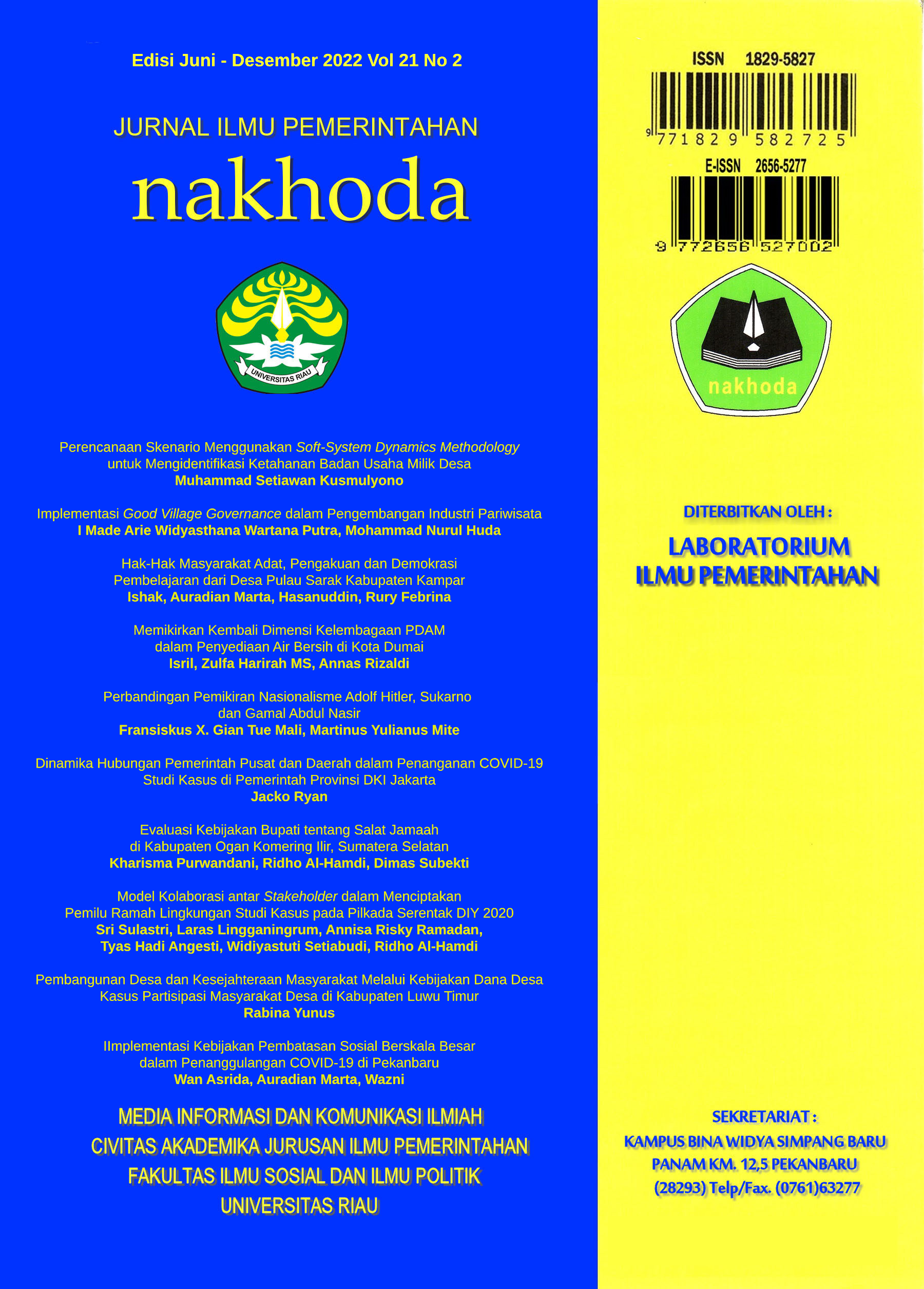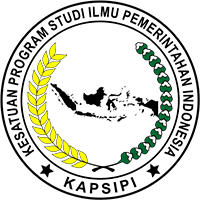Rethinking the Institutional Dimension of PDAM on Clean Water Supply in Dumai City
DOI:
https://doi.org/10.35967/njip.v21i2.376Keywords:
PDAM, Clean Water, Institutional Dimension, LeadershipAbstract
The scarcity of clean water in Dumai City has been going on for decades. PDAM Tirta Dumai Bersemai is required to have good performance so that the distribution of clean water is evenly distributed to all people. However, PDAM faces many challenges in achieving this goal. Challenges in the form of limited funds, human resources, and influential environmental factors so that performance is said to be not optimal. PDAM almost went bankrupt in 2016, trying to get up in 2018-2020 by making various efforts. This paper is intended to explain the success of PDAM in providing clean water. Success is interpreted not as an equal supply of clean water to all people but rather as success in getting through a period of bankruptcy. This research was conducted using qualitative methods by collecting data through interviews and documentation. The field results were then analyzed, resulting in the following findings. First, PDAM can be involved in various clean water supply schemes such as SPAM NUWS, PPP, and Durolis. This involvement shows the trust of the parties in the PDAM's performance. Second, improvements in PDAM performance are inseparable from improvements in PDAM's internal management. Improvement of PDAM's institutional dimension is the key to PDAM's revival. The leadership of the first and second periods of the principal director of PDAM showed significant changes. So that in the future, PDAM leadership must be based on qualified knowledge, information, and experience in managing clean water.
Downloads
References
Astuti, W. K. (2017). Air dan Dialektika Kota Pariwisata: Merebut Hak atas Kota dan Air di Yogyakarta. WACANA: Jurnal Transformasi Sosial, 35, 91–116.
Cole, S. (2012). A political ecology of water equity and tourism. A Case Study From Bali. Annals of Tourism Research, 39(2), 1221–1241. https://doi.org/10.1016/j.annals.2012.01.003
de Souza, M. L. (2006). Together with the state, despite the state, against the state Social movements as “critical urban planning” agents. City, 10(3), 327–342. https://doi.org/10.1080/13604810600982347
Erik Swyngedouw. (2004). Social Power and The Urbanization of Water. Oxford University Press.
Hakim, A. L., Kolopaking, L. M., Siregar, H., & Putri, E. I. K. (2017). Perebutan sumberdaya air: analisis konflik dan politik tata ruang. Sodality: Jurnal Sosiologi Pedesaan, 5(2), 81–91.
Hapsari, D. (2015). Kajian Kualitas Air Sumur Gali dan Perilaku Masyarakat di Sekitar Pabrik Semen Kelurahan Karangtalun Kecamatan Cilacap Utara Kabupaten Cilacap. Jurnal Sains &Teknologi Lingkungan, 7(1), 18–28. https://doi.org/10.20885/jstl.vol7.iss1.art2
Hardani, Auliya, N. H., Andriani, H., Ustiawaty, R. A. F. J., Utami, E. F., Sukmana, D. J., & Ria Rahmatul Istiqomah. (2015). Buku Metode Penelitian Kualitatif dan Kuantitatif. In Pustaka Ilmu (Issue March).
Harirah, Z. (2019). Kerangka Advokasi Koalisi dalam Kebijakan Penataan Pemukiman Bantaran Sungai Winongo di Kota Yogyakarta. Jurnal Ilmu Pemerintahan Nakhoda, 17(30), 128. https://doi.org/10.35967/jipn.v17i30.7065
Harirah, Z., Hadi, S., & Rizaldi, A. (2022). Politics of Water Supply in Industrial City?: Attracting the Interest of PDAM Tirta Dumai Bersemai in Clean Water Distribution. 621–632.
Hatmoko, W., Radhika, & Amirwandi. (2013). Krisis Air dan Kelangkaan Air pada Wilayah Sungai di Indonesia. Pertemuan Ilmiah Tahunan HATHI XXX, Jakarta, January, 8. https://www.researchgate.net/publication/318015189%0AKrisis
Imam Gunawan. (2013). Metode Penelitian. Universitas Negeri Malang.
Kunu, P. J. (2013). Mitigasi krisis air dan in-effisiensi pemanfaatan air di pulau-pulau kecil. Prosiding FMIPA Universitas Pattimura 2013, 27–35.
Mardimin, J. (2014). Program Pembangunan Berkelanjutan ( Kasus Pengelolaan & Pemanfaatan Sumber Air Senjaya di Perbatasan Wilayah Kabupaten Semarang dengan Kota Salatiga ) Oleh?: J . Mardimin Abstract. Kritis, XXIII(2), 131–148.
Martha, J. (2017). Isu Kelangkaan Air dan Ancamannya terhadap Keamanan Global. Jurnal Ilmu Politik Dan Komunikasi, 7(2), 147–149.
OECD. (2016). Water , growth and finance: Policy perspectives. OECD, Better Policies for Better Lives, Water, gro(August), 36.
Prihatin, R. B. (2015). Penyediaan Air Bersih di Indonesia (S. N. Qodriyatun (ed.)). P3DI Setjen DPR RI dan Azza Grafika.
Purcell, M. (2002). Excavating Lefebvre: The right to the city and its urban politics of the inhabitant. GeoJournal, 58(2–3), 99–108. https://doi.org/10.1023/b:gejo.0000010829.62237.8f
Tarigan, H., Dharmawan, A. H., Tjondronegoro, S. M. P., & Suradisastra, K. (2013). Persaingan Akses Sumber Daya Air di Yeh Ho, Tabanan, Bali Access Rivalry to Water Resources in Yeh Ho, Tabanan, Bali. Jurnal Agro Ekonomi. Volume 31 No. 2, Oktober 2013: 143-159, 143–159.
Valentino, D. (2013). Kajian Pengawasan Pemanfaatan Sumberdaya Air Tanah di Kawasan Industri Kota Semarang. Jurnal Wilayah Dan Lingkungan, 1(3), 265. https://doi.org/10.14710/jwl.1.3.265-274
Warren, C. (2000). The Cultural and Environmental Politics of Resort Development in Bali Institute for Social Sustainability The Cultural and Environmental Politics of Resort Development in Bali. http://www.istp.murdoch.edu.au/ISTP/casestudies/Case_Studies_Asia/bali_2/case.html[28/02/2013
Zwarteveen, M., Kemerink-Seyoum, J. S., Kooy, M., Evers, J., Guerrero, T. A., Batubara, B., Biza, A., Boakye-Ansah, A., Faber, S., Flamini, A. C., Cuadrado-Quesada, G., Fantini, E., Gupta, J., Hasan, S., Horst, R. Ter, Jamali, H., Jaspers, F., Obani, P., Schwartz, K., … Wesselink, A. (2017). Engaging with the politics of water governance. Wiley Interdisciplinary Reviews: Water, 4(6), 1–9. https://doi.org/10.1002/wat2.1245
Downloads
Published
How to Cite
Issue
Section
License
Copyright (c) 2022 Authos(s)

This work is licensed under a Creative Commons Attribution-NonCommercial-ShareAlike 4.0 International License.





